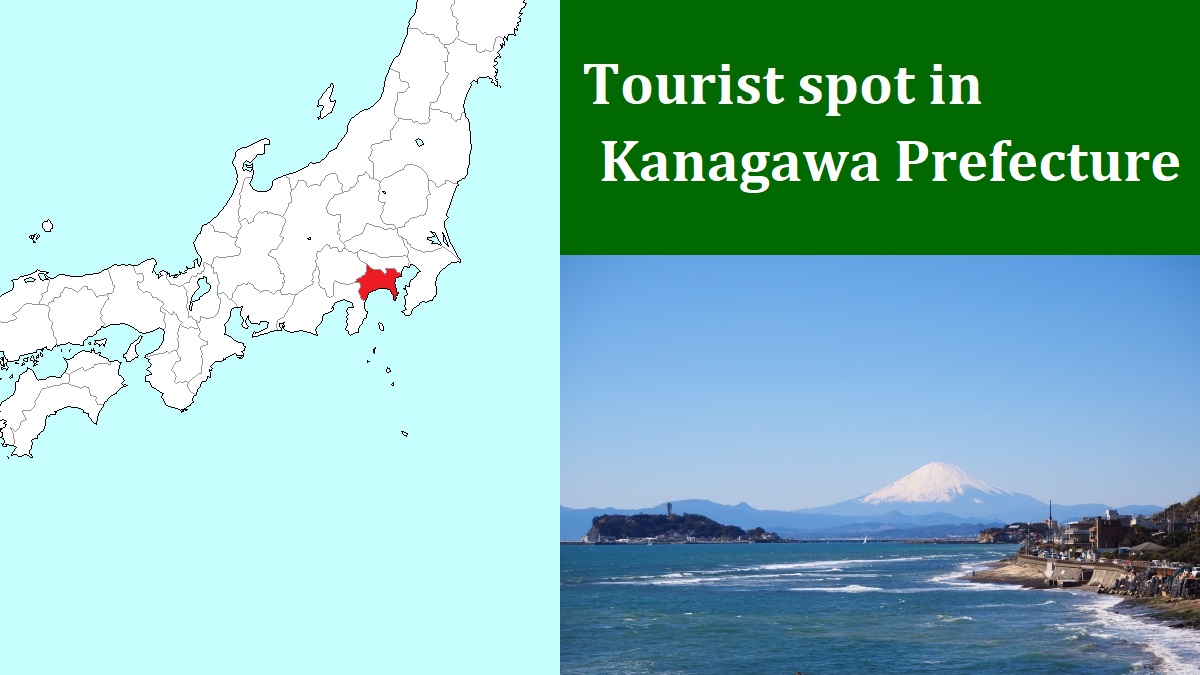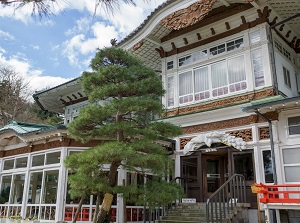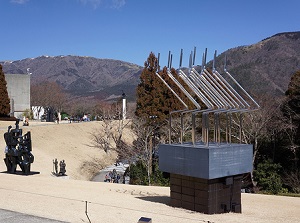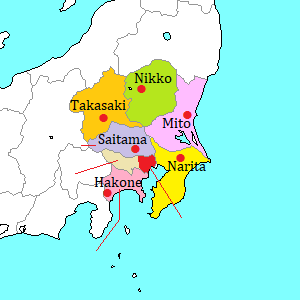Hakone [箱根]
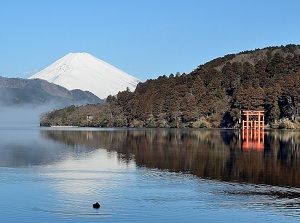
Lake Ashi and Mt.Fuji
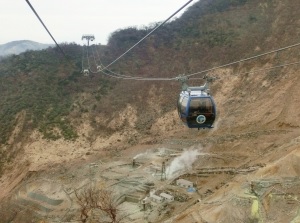
Owakudani
Hakone is one of the popular sightseeing and resort areas in Kanto region.
It is located at southwest part of Kanagawa Prefecture and is at about 80 to 100 km southwest of Tokyo.
Whole Hakone is a caldera volcane named Mount Hakone (箱根山).
The caldera has a diameter of about 15 km.
There are some peaks on the central cone such as Kamiyama (1,438m) and Hakone-Komagatake (1,356m).
On the west side of caldera cone, there is Lake Ashi (Ashinoko, 芦ノ湖) which is a caldera lake.
And, on the north side, Sengokubara field (仙石原) stretches.
An outer rim surrounds this caldera.
Its peaks are about 900 to 1,200 meters high.
Hayakawa River (早川) flows from Lake Ashi, through Sengokubara and east side of caldera cone.
Then it forms a gorge, and flows to the east and into Sagami Bay near Odawara city.
Mount Hakone is an active volcano.
So, we can see some spots emitting volcanic gas and there are many hot spring resorts in this area.
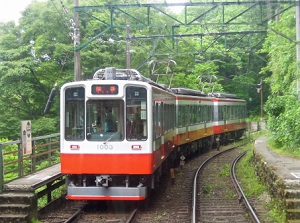
Hakone Tozan Railway
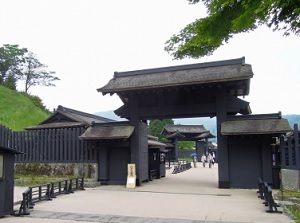
Hakone Checking Station
Since the early 17th century, the main route "Tokaido" between Edo (current Tokyo) and Kyoto passed through here.
And here was a chokepoint on the route, because travelers had to get over a steep pass.
Therefore, Edo govenment placed a checking station here, and they checked the travelers and cargoes strictly to defend Edo city.
Now the main route of railway and expressway don't pass through this area.
Shinkansen and JR Tokaido Line run along the coastline to the southeast, and Tomei Expressway runs along the west side of Hakone.
But this area has various transportations as the sightseeing area.
Mount Fuji is located about 30 km west-northwest of Hakone.
We can see the peak from the high place in Hakone.
When go to Mount Fuji from Hakone, you must change to the route bus in Gotenba city (at JR Gotenba station, or Gotemba Premium Outlets).
Along Hakone Tozan Railway
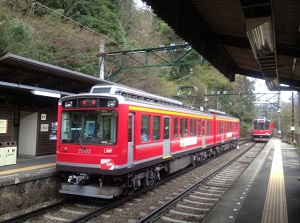
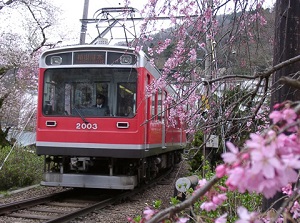
Hakone Tozan Railway (箱根登山鉄道) is the most popular transportation to Hakone.
It runs from Odawara, through Hakone-Yumoto, to Gora, along Hayakawa River.
Between Odawara and Hakone-Yumoto (about 6 km), the slope is gentle.
But between Hakone-Yumoto and Gora (about 9 km), the slope is steep.
The train runs along the steep gorge of Hayakawa River and climbs the difference of height of 445 meters within the short distance.
To climb this route, there are three points of switchback in this section.
Most hot springs in Hakone concentrate in this area along the railway.
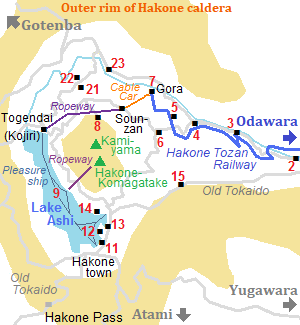
2) Tonosawa 3) Ohiradai 4) Miyanoshita
5) Hakone Open-Air Museum 6) Kowakudani
7) Gora 8) Owakudani 9) Lake Ashi
(1) Hakone-Yumoto (箱根湯本)
It is the largest hot spring resort town in Hakone.
It is located at the entrance to Hakone caldera.
It takes about 15 minutes from Odawara.
The limited expresses come to here directly from Shinjuku and Chiyoda Line of Tokyo Metro subway.
To go to the main area in Hakone, you must change to the train for climbing at this station.
Hayakawa River and Sukumo River are confluent in this town.
There are many hotels and ryokans mainly along Sukumo River to the southwest side of the town.
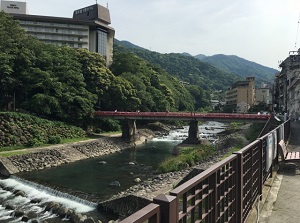
Hakone-Yumoto onsen
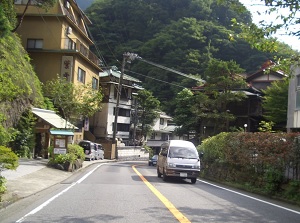
Around Tonosawa onsen town
(2) Tônosawa (塔之沢 (塔ノ沢))
It is a quiet hot spring resort located about 1 km west of Hakone-Yumoto.
The nearest station is Tonosawa.
There are several old established ryokans.
(3) Ôhiradai (大平台)
It is located about 4 km from Hakone-Yumoto.
The nearest station is Ohiradai, and there are three switchbacks of the railway around this station.
There is an old small village and there are a few ryokans in the village.
And there is a public bath "Himenoyu".
(4) Miyanoshita (宮ノ下)
It is located about 6 km from Hakone-Yumoto.
The nearest station is Miyanoshita.
It is an onsen town developed around Kumano Shrine and Hakone Shrine.
Since the late 19th century, Western people visited and stayed here.
So there are some Westernstyle shops along the street.
Fujiya Hotel is the most famous old established ryokan opened in 1878.
Charles Chaplin, Helen Adams Keller, John Lennon and Yoko Ono etc. also stayed in the hotel.
(5) Hakone Open-Air Museum (箱根 彫刻の森美術館)
It is located about 8 km from Hakone-Yumoto.
The nearest station is Chokoku-no-mori, and the Japanese name of the museum is "Chokoku no mori" meaning "forest of sculpture".
It is an open-air museum of art.
There are many sculptures in the large garden.
The creaters of the works are Picasso, Rodin, Moore and other famous artists.
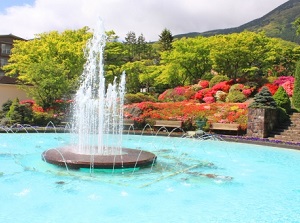
Gora Park
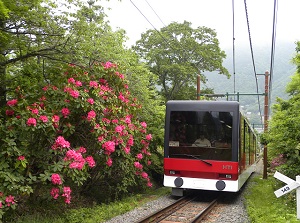
Cable car from Gora
(6) Kowakudani (小涌谷)
It is a hot spring resort located about 1 km west of Miyanoshita.
The nearest station is Kowakidani. (The name is a little different from "Kowakudani".)
It is located about 7 km from Hakone-Yumoto.
An old established ryokan and a few large hotels are dotted.
(7) Gôra (強羅)
It is one of large hot spring resorts in Hakone, and is the terminal of Hakone Tozan Railway.
And there is Gora Park with Western-style gardens about 0.3 km southwest of Gora station.
From here, we can go to Lake Ashi by cable car and ropeway.
Owakudani & Lake Ashi (Ashinoko)
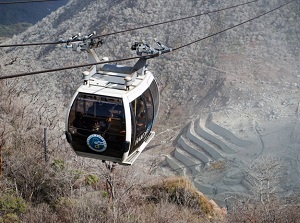
Hakone Ropeway over Owakudani
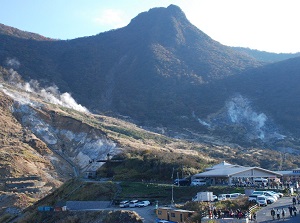
Owakudani
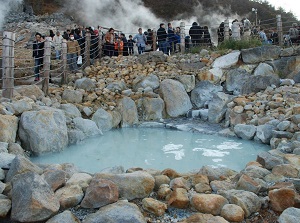
Boiling pond in Owakudani
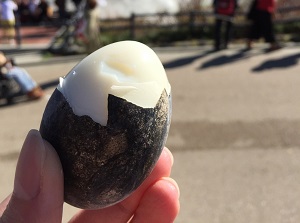
Black egg in Owakudani
(8) Ôwakudani (大涌谷)
It is a valley located to the north of central cone of Mount Hakone.
It is main place emitting the volcanic smoke in Hakone.
A sightseeing road leads to here, and many tourists visit here.
There are some walking trails on the desolate slope.
And we can see the valley from above by ropeway.
(The ropeway connects between Lake Ashi and Sounzan to which we can climb from Gora by cable car.)
The unique speciality in Owakudani is black egg.
It is made by only boilling common eggs in the hot spring in the valley.
The sulfer and iron contents in the spring make the eggshells black by a chemical change.
It is said that eating a black egg gives you extra 7 years.
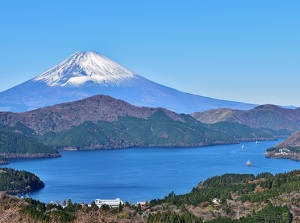
Lake Ashi and Mt.Fuji
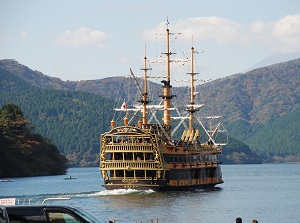
Pleasure ship of Lake Ashi
(9) Lake Ashi (芦ノ湖)
Lake Ashi is a caldera lake in Hakone, and is called "Ashinoko" in Japanese.
It is about 6 km long from north to south, and the width is about 0.6 to 1.5 km.
There is the caldera cone on the east side of the lake, and the caldera wall of outer rim is on the west side.
And the lake is at the level of 723 meters.
The pleasure ships are operating between Kojiri on the north shore and Hakone town area on the south shore.
Kojiri has a terminal of ropeway from Sounzan through Owakudani.
The name of terminal station is Togendai.
Hakone town is the historic town placed the checking station, and is the central town in Hakone area.
Two companies operate the pleasure ships.
They are Hakone-Kankosen and Ashinoko-Yuransen.
They are the rivals, and each company has own pier.
The fare is almost the same.
Ashinoko-Yuransen visits the station of Komagatake Ropeway to Kamagatake peak.
Additionally, if you use a discount coupons with fare of transportation and admission of sightseeing spots in Hakone area, you must board the ship of the designated company on the coupon.
Hakone town (箱根町)
Hakone town is located at the south end of Lake Ashi.
It is the main town of Hakone.
The route of Tokaido passes here.
There are a few historic spots in this town.

11) Hakone Checking Station 12) Onshi-Hakone-Koen 13) Cedar trees 14) Hakone Shrine 15) Hatajuku
(11) Hakone Checking Station (箱根関所)
It is the restored checking station in operation from 1619 to 1869.
It is located to just north of the port of pleasure ship.
In Japanese, it is called "Hakone Sekisho".
Because Hakone was the important place to enter Edo (Tokyo), the government officials checked all travelers and cargoes strictly here.
All travelers were forced to show the passport.
It was strictly prohibited to bring guns from western area to Edo in order to ensure security of Edo.
Some buildings and gates have been precisely reproduced.
And there is the museum of this sekisho.
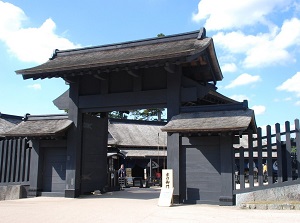
Entrance gate of Hakone Sekisho
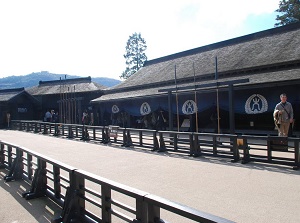
Hakone Sekisho
(12) Onshi-Hakone-Koen Park (恩賜箱根公園)
Here was a detached palace of Emperor's family since 1886, but it was destroyed by the Kanto Great Earthquake in 1923.
Then the site was donated to Kanagawa Prefecture in 1946.
It is on a small peninsula near Hakone Checking Station.
Now, there are gardens and forests in this site, and we can see Lake Ashi and Mount Fuji.
(13) Old road lined with cedar trees (旧街道杉並木)
The old road of Tokaido passes this town.
Between Hakone Checking Station and Onshi-Hakone-Koen Park, there is old cedar trees on the both side of the road.
It is said that they were planted by order of Edo government in 1618.
We can find the scenery of those days.
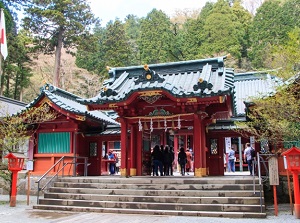
Hakone Shrine
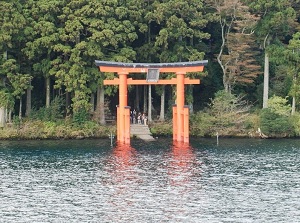
Torii gate of Hakone Shrine
(14) Hakone Shrine (箱根神社)
It is a Shinto shrine located about 2.5 km north of Hakone town.
It is said that it was founded in 757.
The shrine has been known as a place for mountain worship that Hakone-Komagatake is treated as an object of worship.
The main shrine is on the lakeside, and the main Torii gate is in the lake.
(15) Hatajuku (畑宿)
It is a small town in the south valley of caldera and is located about 5 km northeast of Hakone town.
It is known for Yosegi-zaiku which is a traditional woodwork in Hakone.
There is "Yosegi Kaikan", a museum introducing Yosegi-zaiku, in the center of the town.
And there are some workshops of Yosegi-zaiku in the town.
Sengokubara area
Sengokubara area is the north part of caldera in Hakone, and is located at a height of 600 to 700 meters.
Hayakawa River flows through this area from southwest to southeast.
Grasslands and wetlands are spread, and there are some unique museums in this area.
In additon, there is Gotenba city about 10 km northwest of this area after crossing the outer rim of Hakone.
From Gotenba, there is a route to Mount Fuji.

21) Sengokubara 22) Botanical Garden of Wetlands 23) Venetian Glass Museum 24) Museum of The Little Prince
(21) Sengokubara field (仙石原)
It is the grassfield, and stretches a few kilometers along Hayakawa River.
And there is Mount Daigatake which is one of the central cone to the east.
It is known for the field of Japanese silver grass in autumn.
(22) Hakone Botanical Garden of Wetlands (箱根湿生花園)
It is a botanical garden like a natural park, and the whole site is in Sengokubara wetland.
There are about 200 kinds of Japanese wetland plants, 1,300 kinds of highland and alpine plants and 200 kinds of foreign plants.
It is closed from December 1 to March 19.
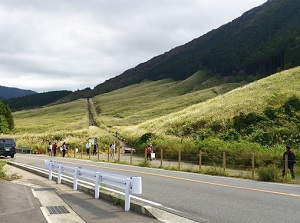
Sengokubara
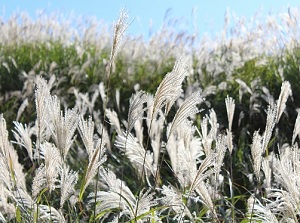
Silver grass in Sengokubara
(23) Venetian Glass Museum (箱根ガラスの森美術館)
It is a museum displaying traditional and modern works of Venetian glass.
There are some European-style buildings for museums and shops around a pond.
How to get here
Hakone Tozan Railway, Cable Car and Ropeway
- From Odawara to Hakone-Yumoto, the trains of Odakyu run.
It takes about 14 minutes.
From Hakone-Yumoto to Gora, the mountain trams of Hakone Tozan Railway run.
About 25 minutes to Miyanoshita, about 38 minutes to Gora. - From Gora to Sounzan, about 10 minutes by cable car.
- From Sounzan to Togendai, about 30 minutes by ropeway.
Pleasure ships of Lake Ashi
- From Kojiri (Togendai) to Hakone town, about 40 minutes.
Route buses in Hakone
- Odawara (15min) Hakone-Yumoto (11min) Miyanoshita (33min) Hakone town
- Odawara (15min) Hakone-Yumoto (28min) Sengokubara (16min) Kojiri
- Hakone-Yumoto (20min) Hatajuku (25min) Hakone town
- Yugawara (37min) Hakone town
- Gotenba (35min) Gora
Pass for travel around Hakone
There is no route of JR railway in Hakone.
So Japan Rail Pass is not available in this area.
Instead, the convenient passes are available.
But each pass is available to the transportations of limited companies.

